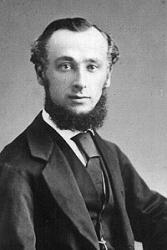Go Ad-Free
If you regularly use Hymnary.org, you might benefit from eliminating ads. Consider buying a Hymnary Pro subscription.
If you regularly use Hymnary.org, you might benefit from eliminating ads. Consider buying a Hymnary Pro subscription.

1 Come to the Savior now,
he gently calls to you;
in true repentance bow,
let him your heart renew.
Christ came that you may know
salvation, peace, and love,
true joy on earth below,
a home in heaven above.
2 Come to the Savior now,
all who have wandered far;
renew your solemn vow,
for his by right you are;
come like poor, wandering sheep
returning to his fold;
his arm will safely keep,
his love will ne'er grow cold.
3 Come to the Savior, now,
he offers all to you,
and on his merits you
can plead for life anew.
No vain excuses frame,
respond to Christ today!
None who to Jesus came
were ever sent away.
4 Come to the Savior, all,
whate'er your burdens be;
hear now His loving call,
"Cast all your care on me."
Come, and for every grief,
in Jesus you will find
a sure and safe relief,
a loving friend and kind.
Source: Lift Up Your Hearts: psalms, hymns, and spiritual songs #613
 Wigner, John Murch, second son of J. T. Wigner, was born at Lynn, June 19, 1844. He was educated at the Grammar School of Lynn, and afterwards graduated B.A. and B.SC. in the London University. Mr. J. M. Wigner now resides near London, and has been for many years in the India Home Civil Service. He is connected with his father's church, and has done much to promote the spiritual welfare of the young. He is the author of several hymns, three of which are in the Baptist Psalms and Hymns for School and Home, 1882;—
1. "Come to the Saviour now!" Invitation.
2. "Lost one! wandering on in sadness." Return to God.
3. "Lo, a loving Friend is waiting." The Call of Jesus.
The first of these is in the Baptist Psalms & Hymns, 1880, and… Go to person page >
Wigner, John Murch, second son of J. T. Wigner, was born at Lynn, June 19, 1844. He was educated at the Grammar School of Lynn, and afterwards graduated B.A. and B.SC. in the London University. Mr. J. M. Wigner now resides near London, and has been for many years in the India Home Civil Service. He is connected with his father's church, and has done much to promote the spiritual welfare of the young. He is the author of several hymns, three of which are in the Baptist Psalms and Hymns for School and Home, 1882;—
1. "Come to the Saviour now!" Invitation.
2. "Lost one! wandering on in sadness." Return to God.
3. "Lo, a loving Friend is waiting." The Call of Jesus.
The first of these is in the Baptist Psalms & Hymns, 1880, and… Go to person page >| First Line: | Come to the Savior now, He gently calleth thee |
| Title: | Come to the Savior Now |
| Author: | John M. Wigner (1871, alt.) |
| Meter: | 6.5.6.5 D |
| Language: | English |
| Copyright: | Public Domain |
Scripture References:
st. 2 = Isa. 53:6
st. 4 = Matt. 11:28-30, Ps. 55:22, 1 Pet. 5:7
John M. Wigner (b. King's Lynn, Norfolk, England, 1844; d. London, England, 1911) wrote this text in 1871 for use with the young people of the church where his father was a Baptist minister. The hymn was published in his father's Supplement to the Baptist Psalms and Hymns in 1880 (Wigner's father had also compiled the original edition of this hymnal in 1858). Educated at London University, Wigner served in various capacities at his church, especially working with young people. After 1876 Wigner was employed in the Indian Home Office in London.
Like 534, this invitation hymn makes use of biblical phrases and imagery. We are called to come to the Savior in repentance and for renewal. The text makes an urgent, direct appeal (st. 3) to come to Christ for salvation, relief from our burdens, and eternal rest.
Liturgical Use:
As an invitation hymn in evangelistic services, possibly with altar calls or with the Lord's Supper; useful in the service of confession/forgiveness.
--Psalter Hymnal Handbook


 My Starred Hymns
My Starred Hymns